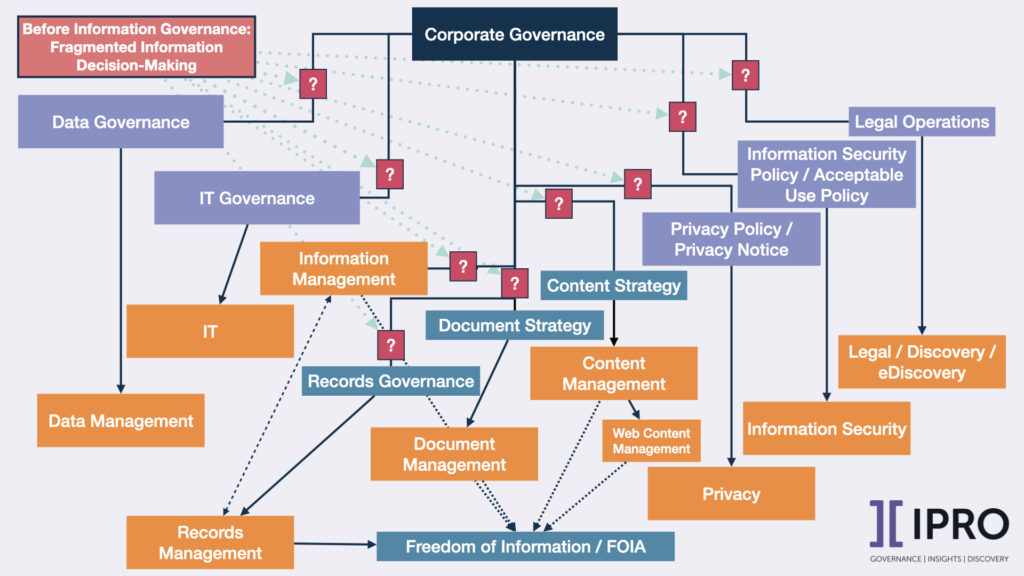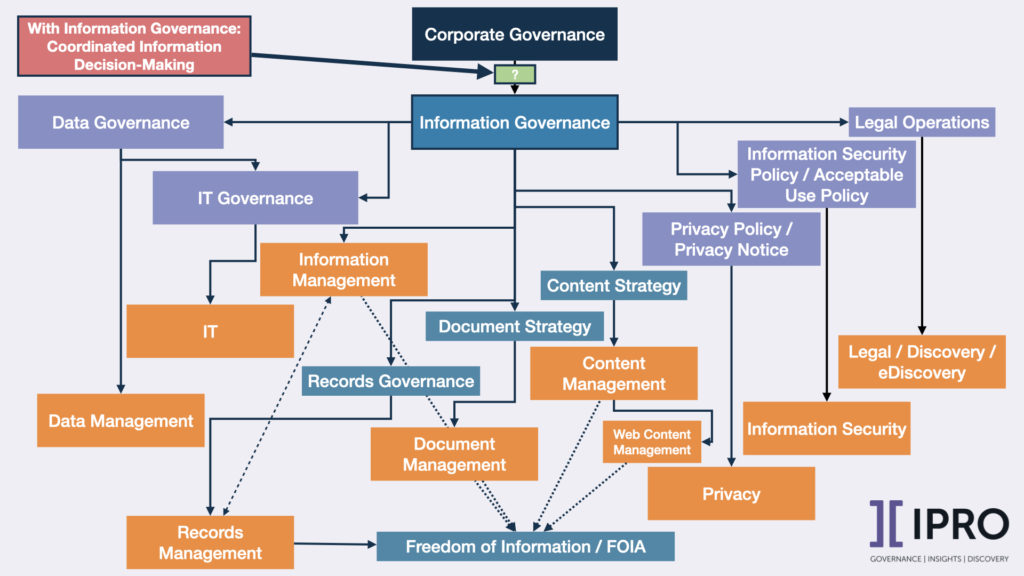
By Nick Inglis, Director of Information Governance at IPRO
Coordinating and making better organizational information decisions can be a challenge for any organization.
It’s a lot easier said than done when an onslaught of ever-growing, evolving, and expanding data overwhelms your organization. Further, our decision-making around information is often delegated to various individuals within our organizations with limited scopes (e.g., a Records Manager making decisions only about the records repository or an attorney making decisions only about eDiscovery processes). If these individuals don’t coordinate on these processes, there’s a high likelihood for them to make decisions in one essential area that conflict with decisions made in other key areas.
What is Information Governance
Various information professionals, myself included, participated in the development of a new discipline to solve this challenge: Information Governance. This information-coordinating discipline focuses on uncovering the multiple sets of information decisions an organization makes across disciplines and harmonizing them into a single, master set of information decisions, often articulated as policy statements.
It makes good business sense for an organization to shift to such an information governance-based strategy and for all information professionals (yes, even eDiscovery professionals) to develop and master new skill sets that enable them to appropriately follow it. Such a framework may very well be the bedrock to ensuring organizational success in today’s frenetic information landscape. Fortunately, executives responsible for coordinating and making better organizational information decisions have plenty of tools at their disposal — both inside their organizations and outside resources that are available — to make it happen (including solutions from IPRO).
Sometimes it’s easier to see a visual representation of a challenge (and a solution). It may take a moment to orient yourself to the below graphic. Be sure to give it enough time for it to make sense. Let’s start with our pre-Information Governance state in a visualized (and, yes, simplified) form:
graphic. Be sure to give it enough time for it to make sense. Let’s start with our pre-Information Governance state in a visualized (and, yes, simplified) form:

In this pre-IG stage, information decisions are delegated to various disciplines and professionals across the organization. Corporate governance exists in most organizations, but decisions around the information are often entirely disconnected from corporate governance. Since the decisions are also so far removed from corporate governance, they’re also often not informed by corporate governance at all.
In this model, there are various points where information-related decisions are made. If policies are distributed throughout organizations, inconsistencies in information handling are likely happening. If you’re thinking ahead, you’re likely to be viewing those multiple decision points as multiple points where various information failures can occur: breaches, hacks, lost information, and the like are all made possible by information failures.
A New Way Forward with Information Governance
What if there was a better way forward? Fortunately, there is, and now, many organizations have embarked on an approach that often looks similar to this:

An Information Governance-enabled organization has an aligned set of information decisions, and those decisions are propagated throughout the organization. In this model, it’s easier to connect the information policies to the corporate stance because the decision-making is closer to organizational strategy. Yes, Information Governance is a subset of overall Corporate Governance.
Further, you’re able to (finally) have a comprehensive policy in place to remove inconsistencies in your information policies and handling, which may have had detrimental effects on your organization.
Information Governance is typically referred to as “policy-driven” governance instead of “control-driven” traditional governance. Policy refers to a statement or set of statements that demonstrate the principles, values, or objectives of an organization. In contrast, control refers to elements that directly govern implementation of policies (e.g., budgets and staffing). When organizations manage information decisions more through policy than control it helps ensure they are more aligned with desired outcomes.
Creating a standard set of information policies through the discipline of Information Governance requires that all sub-disciplines actively participate in the decision-making process – with a chosen and empowered leader (or leadership team) to help settle any potential disputes.
Information Governance isn’t just some made-up term or a rebranding of previous processes. And it’s not just some fad or hype-cycle term.
It’s a different approach to organizational information – a strategic approach. It’s how we will all approach information in the future because it makes excellent business sense to approach information in this way, in addition to being the only sustainable way forward given the relentless growth in the quantity of unstructured information that businesses want to create, share and preserve.
Learn more about how IPRO solutions can enable your organization to move toward an information governance-based strategy.



